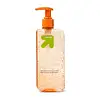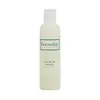What's inside
What's inside
 Key Ingredients
Key Ingredients

No key ingredients
 Benefits
Benefits

 Concerns
Concerns

 Ingredients Side-by-side
Ingredients Side-by-side

Water
Skin ConditioningSodium Laureth Sulfate
CleansingGlycerin
HumectantCocamidopropyl Betaine
CleansingAcrylates Copolymer
Parfum
MaskingMannitol
HumectantPhenoxyethanol
PreservativeMenthyl Lactate
MaskingCellulose
AbsorbentDisodium EDTA
Methylparaben
PreservativeMenthol
MaskingPropylparaben
PreservativeTocopheryl Acetate
AntioxidantEthylparaben
PreservativeSodium Hydroxide
BufferingSodium Ascorbyl Phosphate
AntioxidantRetinyl Palmitate
Skin ConditioningHydroxypropyl Methylcellulose
Emulsion StabilisingAcrylates/Ammonium Methacrylate Copolymer
Triethyl Citrate
MaskingCucumis Sativus Fruit Extract
EmollientCitrus Grandis Fruit Extract
AstringentPanax Ginseng Root Extract
EmollientZingiber Officinale Root Extract
MaskingIron Oxides
Titanium Dioxide
Cosmetic ColorantMica
Cosmetic ColorantTalc
AbrasiveWater, Sodium Laureth Sulfate, Glycerin, Cocamidopropyl Betaine, Acrylates Copolymer, Parfum, Mannitol, Phenoxyethanol, Menthyl Lactate, Cellulose, Disodium EDTA, Methylparaben, Menthol, Propylparaben, Tocopheryl Acetate, Ethylparaben, Sodium Hydroxide, Sodium Ascorbyl Phosphate, Retinyl Palmitate, Hydroxypropyl Methylcellulose, Acrylates/Ammonium Methacrylate Copolymer, Triethyl Citrate, Cucumis Sativus Fruit Extract, Citrus Grandis Fruit Extract, Panax Ginseng Root Extract, Zingiber Officinale Root Extract, Iron Oxides, Titanium Dioxide, Mica, Talc
Water
Skin ConditioningCocamidopropyl Betaine
CleansingGlycerin
HumectantDecyl Glucoside
CleansingLauryl Glucoside
CleansingXanthan Gum
EmulsifyingGlycyrrhiza Glabra Root Extract
BleachingFomes Officinalis Extract
Skin ProtectingCamellia Oleifera Leaf Extract
AstringentPanthenol
Skin ConditioningDisodium EDTA
Hamamelis Virginiana Water
AstringentCitric Acid
BufferingAlcohol
AntimicrobialButylene Glycol
HumectantPotassium Sorbate
PreservativePhenoxyethanol
PreservativeEthylhexylglycerin
Skin ConditioningWater, Cocamidopropyl Betaine, Glycerin, Decyl Glucoside, Lauryl Glucoside, Xanthan Gum, Glycyrrhiza Glabra Root Extract, Fomes Officinalis Extract, Camellia Oleifera Leaf Extract, Panthenol, Disodium EDTA, Hamamelis Virginiana Water, Citric Acid, Alcohol, Butylene Glycol, Potassium Sorbate, Phenoxyethanol, Ethylhexylglycerin
Ingredients Explained
These ingredients are found in both products.
Ingredients higher up in an ingredient list are typically present in a larger amount.
Cocamidopropyl Betaine is a fatty acid created by mixing similar compounds in coconut oil and dimethylaminopropylamine, a compound with two amino groups.
This ingredient is a surfactant and cleanser. It helps gather the dirt, pollutants, and other impurities in your skin to be washed away. It also helps thicken a product and make the texture more creamy.
Being created from coconut oil means Cocamidopropyl Betaine is hydrating for the skin.
While Cocamidopropyl Betaine was believed to be an allergen, a study from 2012 disproved this. It found two compounds in unpure Cocamidopropyl Betaine to be the irritants: aminoamide and 3-dimethylaminopropylamine. High-grade and pure Cocamidopropyl Betaine did not induce allergic reactions during this study.
Learn more about Cocamidopropyl BetaineDisodium EDTA plays a role in making products more stable by aiding other preservatives.
It is a chelating agent, meaning it neutralizes metal ions that may be found in a product.
Disodium EDTA is a salt of edetic acid and is found to be safe in cosmetic ingredients.
Learn more about Disodium EDTAGlycerin is already naturally found in your skin. It helps moisturize and protect your skin.
A study from 2016 found glycerin to be more effective as a humectant than AHAs and hyaluronic acid.
As a humectant, it helps the skin stay hydrated by pulling moisture to your skin. The low molecular weight of glycerin allows it to pull moisture into the deeper layers of your skin.
Hydrated skin improves your skin barrier; Your skin barrier helps protect against irritants and bacteria.
Glycerin has also been found to have antimicrobial and antiviral properties. Due to these properties, glycerin is often used in wound and burn treatments.
In cosmetics, glycerin is usually derived from plants such as soybean or palm. However, it can also be sourced from animals, such as tallow or animal fat.
This ingredient is organic, colorless, odorless, and non-toxic.
Glycerin is the name for this ingredient in American English. British English uses Glycerol/Glycerine.
Learn more about GlycerinPhenoxyethanol is a preservative that has germicide, antimicrobial, and aromatic properties. Studies show that phenoxyethanol can prevent microbial growth. By itself, it has a scent that is similar to that of a rose.
It's often used in formulations along with Caprylyl Glycol to preserve the shelf life of products.
Water. It's the most common cosmetic ingredient of all. You'll usually see it at the top of ingredient lists, meaning that it makes up the largest part of the product.
So why is it so popular? Water most often acts as a solvent - this means that it helps dissolve other ingredients into the formulation.
You'll also recognize water as that liquid we all need to stay alive. If you see this, drink a glass of water. Stay hydrated!
Learn more about Water